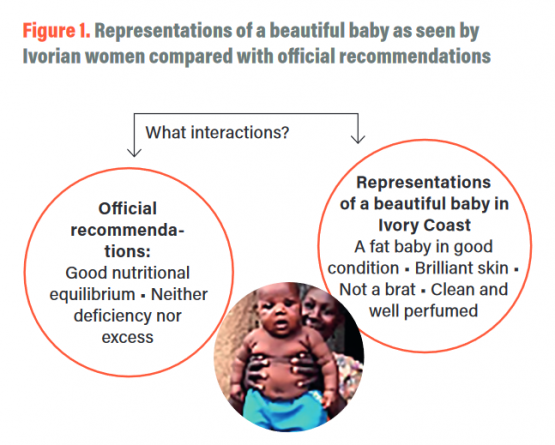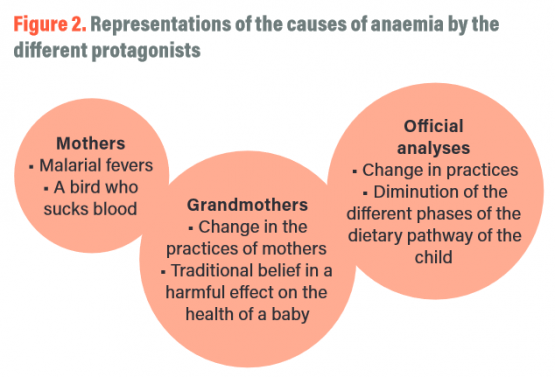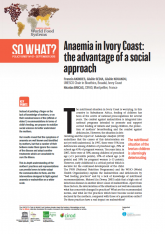Home > Publications > Policy Briefs > 1/ Anaemia in Ivory Coast: the advantage of a social approach
– Instead of pointing a finger on the lack of knowledge of mothers, or on their nonobservance of the (official or elders’) recommandations in terms of child’s feeding, we propose to mobilize social sciences to better understand the mothers.
– Our results reveal that the symptoms of anaemia are well known and identified by mothers, but that a number of their believes make them ignore the causes of the disease and adopt curative treatments which are unsuitable to cure the illness.
– This in-depth understanding of the mothers’ practices and representations can provide levers to better adapt the communication to them, and the interventions designed to fight against anaemia or malnutrition on a wider scale.
The nutritional situation in Ivory Coast is worrying. In this country in Subsaharan Africa, feeding of children has been at the centre of national preoccupations for several years. The combat against malnutrition is integrated into national programs intended to promote and support correct feeding of infants and young children, the protec-tion of mothers’ breastfeeding and the combat against deficiencies. However, the situation is deteriorating and the report of Landscape Analysis (2010) underlines that the causes of this deterioration are not yet well understood. In 1997, there were 35% iron deficiencies among children of preschool age, 29% of school age 45% of pregnant women. Ten years later, in 2007, there were at 50% among children of preschool age (+15 percentile points), 59% of school age (+30 points) and 58% for pregnant women (+13 points).
However, early childhood is a critical period which is decisive for the continued development of the child. The PNN (National Nutrition Programme) and the WHO (World Health Organization) explain the malnutrition and deficiencies by “bad feeding practices” and by a lack of knowledge of nutritional recommendations. Matorel (in Dewey, 2003) adds that a high rate of infectious diseases is another direct cause of malnutrition. Apart from these factors, the deterioration of the situation is not well documented: what has concretely changed in practices? What are the recommended norms, and what are the practices which have become social norms declared by the mothers, compared with those of a generation earlier? Do these practices have a real impact on malnutrition?
The report of Landscape Analysis favours a socio-logical study of practices in order to understand the situation better. A more urbanised mode of life implies changes in economic and social norms, and probably changes in behaviour. The model of the family may develop, sources of influence change, but the lack of recent reliable data allowing the documentation of practices and the sources of their changes, particularly with respect to children of less than 3 years of age, makes it more difficult to take effective decisions in the battle against malnutrition. The issue of this study is therefore to propose a diagnosis with respect to the change in practices: is this change real? How is malnutrition perceived, particularly anaemia? And how is it termed culturally? What are the known symptoms ? And what is used in order to counteract it? Which causes are blamed?
In order to answer these questions, a team of socio-anthropologists tried to analyse the development of ways of feeding children and the links between these and iron deficiencies in urban and semi-urban areas in Ivory Coast.
The first objective was to understand the practices of feeding children and compare the representations of mothers and grandmothers, as well as official recommendations on the correct practices to follow in order to have a baby in good health. The second objective was to evaluate the knowledge of the different socio-economic categories on the links between feeding and anaemia, in order to under-stand the social issues surrounding anaemia.
The official recommendations
The specialists—paediatricians, nursery nurses, obstetricians, midwives, etc.)—base their advice on international recommendations, in other words those of the WHO or UNICEF (Children’s Rights & Emergency Relief Organization). A child in good health is in accordance with official norms in terms of nutrition, and these professionals explain the problems of public health and malnutrition by bad feeding practices.
The ideal of mothers and older people
For the population of Ivory Coast, a “beautiful” baby is a baby who is “in good shape”, in good health and not frail, as a sign that it does not have fragile health and is not underfed. Its complexion must also be brilliant, it must be clean and perfumed in order to give people the desire to carry and caress it, and hence make its mother proud. In order to get closer to this ideal, practices are oriented, during pregnancy with multiple rules for the mother, dietary or otherwise, and after birth, towards beliefs aiming to make the baby fatter. Neo-urban mothers use strategies to stimulate the appetite, so that the baby will eat what is presented to it. Among the feeding practices we note in particular the use of vitamins and foods with added vitamins such as “custard powder”, a flour for young children manufactured in Nigeria. Particularly for neo-urban mothers, who are still caught in a vice between traditional values and urban norms, a fat baby is a baby whose mother takes good care of it, and hence it is something to be proud of and a social symbol. Moreover, in the representations there is a strong link between the health of the child and what is revealed about the socio-economic situation of the household.
The issues relating to the appearance of the child therefore influence the perceptions and/or statements of interviewees relating to anaemia.

Cultural knowledge of the illness
Anaemia is well known to the Ivoirians. There are as many names for this illness as there are ethnic groups, which is proof that it is old enough for the different generations to know what to call it, unlike child obesity which is more difficult to perceive for the women interviewed. For example it is designated by the names of “M’piamomonsè” in the Abey ethnic group and “Djoriko” in the Dioula ethnic group. These terms mean: “the child has no more blood in its body” or “the blood is finished in its body”: the image is therefore of the blood drying up in the body of the child.
Recognition of the symptoms
The symptoms are easily described by the inter-viewees: a tired child, with a pale complexion and eyes, out of breath at the least effort, who does not play any more, the soles of whose feet and the palms of whose hands are cold and yellowish, who has fever and loses his appetite, sometimes with headaches. Anaemia is therefore well recognised by these signs which go against the ideal of a beautiful baby.
Curative and therapeutic practices used
Several remedies are used: non-dietary therapies include pharmaceutical products prescribed in health centres and/or plant-based treatments in the form of a herbal tea or decoction of a blood red colour, prepared by a traditional practitioner, with leaves of teak or anango. The trust placed in these products varies, and according to interviewees decoctions and herbal teas are more effective than pharmaceutical products. It may be noted that the non-medicinal therapeutical approach is more common among the less privileged social classes.
Among dietary therapies, there is a recipe prepared with 33 cl of Coca Cola® and a can of 100g of tomato concentrate. If the origin of this recipe is unclear, its effectiveness is “recognised” by inter-viewees. Roselle juice is also consumed for its supposed therapeutical virtues, in connection with its red colour, as if it could correct the deficiency of blood. Besides this particular recipe, the diet of the child is changed by including more leaves: spinach, potato leaves or manioc leaves, and if available income permits, some beef liver can be added.
It may be noted that these traditional remedies, the particular recipe and the decoctions, are of a red colour.
To conclude, the illness is well-known among Ivoirian women, who name it easily and know its symptoms and remedies. However, the causes are more a subject of debate, as are the ways of preventing it.
Aetiologies of anaemia: the official causes and the beliefs of mothers and grandmothers
Understanding the causes attributed to anaemia seems to be a key factor in being able to combat malnutrition. In fact, it is necessary to propose solutions which are appropriate for beliefs transmitted from generation to generation in the population, bearing in mind the recommendations of official authorities who have difficulties in understanding how to have an impact on the practices.
Grandmothers accuse the new practices of mothers
Grandmothers make the criticism that weaning takes place too early, and refer to inappropriate feeding of the infant, with the premature stopping of exclusive breastfeeding. They question the decisions taken by the mothers, who do not offer the same dietary pathway to the child as in their time. It is also suspected that the post-partum period of sexual abstinence is not adhered to: the mother is thought to have “infected” her baby with her sexuality, which is thought to be dangerous for the child. Grand-mothers therefore blame the mothers’ failure to adhere to traditions, in the area of feeding but also more generally.
Mothers find it more difficult to recognise the dietary cause
The mothers find it more difficult to recognise the dietary cause of the anaemia; perhaps it is through real ignorance, or because, through an indirect process, this would designate them as being responsible. The health of the child is indeed a source of pride and, in the social imagination, is linked with the situation of the household. The mothers may therefore feel directly responsible, and damaged in terms of the representation of their socio-economic situation, since recognising a dietary cause would entail admitting the precarious conditions of their household. Hence instead some link anaemia with malaria: strong repeated fevers are thought to cause the child’s blood to evaporate and explain its diminution. A “bird that sucks blood” is also cited as a reason for blood which dries up, or “it’s an illness of the modern era”. This last expression underlines the fact that even if it is culturally known, perhaps in the “modern era” or modern times this disease is observed and recognised more and more.
Official statements
In official analyses, the health of the child is directly linked to the stage of diversification. The changes in dietary practices regarding the feeding of children are seen as a possible cause. The mode of life has indeed developed, with a new family environment: an economically active woman, a monogamous couple and hence the importance of keeping one’s husband by resuming sexual activity, and a less multigenerational family, with a grand-mother who is sometimes less present to help, and replaced by nannies and assistants who take her role. In this mode of life, the period of exclusive breast-feeding is shortened with respect to traditional norms, and after 3 months it is common practice to introduce gruels, or industrial foods for the wealthier classes. This stage seems to be of key importance, and vitamin deficiencies are generally rare for children who are exclusively breastfed (Dewey, 2003). In a general manner, all of the phases of the dietary pathway are reduced compared with the traditional norms described by the grandmothers, and from the age of 8 months onwards the particular attention paid to the feeding of the child diminishes, with the latter eating like other members of the family. According to the mothers, the first crises of anaemia appear around the age of one—could it be that they are linked to this change in practices?

The feeding of children is a social field of the confrontation of norms (scientific and socio-cultural) which is permanently subject to the influences of societal transformations. For the mothers, feeding their babies and children means perpetually making a choice between what is desirable, what is socially acceptable and what is possible. What is possible must take into account the multiple functions and social statuses within the identity of a woman: the function of a mother, of a wife or partner, but also the status of an economically active woman in this new “urbanised” mode of life. It is in the hollow caused by this confrontation of scientific norms and practices (which themselves have become norms) that the discrete transformations in the dietary pathway of children are situated. It is therefore important to understand the gap between norms and feeding practices, and above all to understand the social factors in practices of feeding children, if it is desired to prevent anaemia by paying particular attention at the time of diversification. This sociological approach has made it possible to better understand some factors which were difficult to grasp using a purely nutritional approach.
The study [1] took places in urban and semi-urban surroundings in the cities of Abidjan and Bouaké, from May to August 2013. Abidjan, the economic capital, is in the south of the country, and Bouaké is in the centre. In this urban context of a strong interaction of modernity and tradition, the issues surrounding the development of practices appear more clearly.
In the study, interviews were carried out with 100 mothers and grandmothers of children from 0 to 3 years who had been confronted with anaemia. They were questioned on the therapeutic and non-medicinal measures used against anaemia and the associated social representations. Surveying several generations makes it possible to compare practices in order to understand their developments.
The populations of these two cities showed diverse profiles in terms of socio-professional categories and ethnic and geographic origins. 50 women were interviewed in each city: 33 mothers and 17 grandmothers in Abidjan and 34 mothers and 16 grandmothers in Bouaké.
Semi-directive interviews lasting between 2 and 3 hours were carried out, and data from statements were sometimes supplemented with observation, when the meeting took place during breastfeeding, the preparation of meals or children’s mealtimes.
In order to take a closer look at the divergences between the norms of grandmothers, mothers, and the official recommendations, particularly with respect to childhood anaemia, two focus group meetings were also carried out in Abidjan and Bouaké.
– Francis AKINDES, Gisèle SEDIA, Gisèle KOUAKOU, UNESCO Chair in Bioethics, Bouaké, Ivory Coast
– Nicolas BRICAS, CIRAD, Montpellier, France
République de Côte d’Ivoire, Cabinet du Premier Ministre et Ministère de la Planification du Développement, 2009. Document Stratégique de Réduction de la Pauvreté, 198 p.
Dewey K., 2003, Principes directeurs pour l’alimentation complémentaire de l’enfant allaité au sein, WHO-PHO, 36 p
République de Côte d’Ivoire, Ministère de la santé et de l’hy-giène publique, 2010. Rapport du Landscape Analysis pour la Côte d’Ivoire, Programme National de Nutrition, 74 p.
[1] The data contained in this article are from a collaborative research project on the food styles between the Unesco Chair in Bioethics Bouaké (Côte d’Ivoire), the French agricultural research and international cooperation organization (CIRAD), Danone Nutricia Africa and Overseas, Danone Nutricia Research and Agropolis Fondation.
